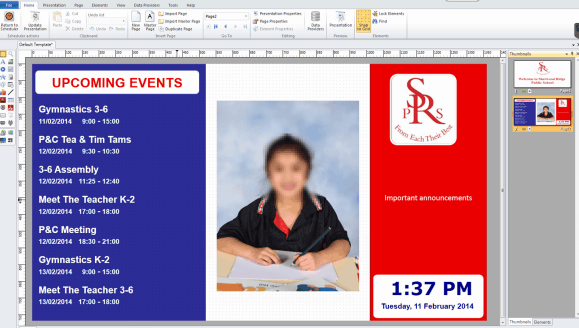Advertise Me recently integrated Sherwood Public School’s digital signage system with Sentral.
What is Sentral?
 Sentral is an industry leading software platform to manage student and administration data for Kindergarten to Year 12 schools. It has been installed in over 1200 schools across Australia and is expanding both nationally and internationally. It features an easy to use web interface so administration staff and teachers can manage student enrolment data, timetable information, student attendance, communication with parents and the list goes on. It is a comprehensive system and was built from the ground up in consultation with teachers, principals and other schools.
Sentral is an industry leading software platform to manage student and administration data for Kindergarten to Year 12 schools. It has been installed in over 1200 schools across Australia and is expanding both nationally and internationally. It features an easy to use web interface so administration staff and teachers can manage student enrolment data, timetable information, student attendance, communication with parents and the list goes on. It is a comprehensive system and was built from the ground up in consultation with teachers, principals and other schools.
The opportunity
Sherwood originally requested to display the School’s upcoming events on a section of the digital screen that was located in the reception area. The plan was to manually add and delete event information on the digital signage system on a daily or weekly basis. Advertise Me saw this as a tedious task so we asked the question, “Does the school already have these events entered on any other system?”. Their answer was “Sentral”. We had no clue what, who and where Sentral was. So the client went ahead and showed us the Sentral system and explained how this information is displayed on the School’s website and also on their Smartphone App. This is where we saw the opportunity to integrate our digital signage system with Sentral to display the events information on the screen using a central system (maybe that why it’s called Sentral).
The solution
We contacted Sentral support that afternoon to discuss our options and to further understand how the event information could be retrieved from their system. We found the Sentral support staff to be very knowledgeable and were very helpful in providing us with the right information. The next day we had a solution. We built a custom script that would automatically export the events from the Sentral calendar system and then import the data into our digital signage system. We also customised our system to automatically display images from a network folder so all the staff had to do is copy and paste the images in this folder. This meant that they didn’t even need to open the digital signage program to upload the content. On top of that, we created a Rich Text File on their desktop for updating Important announcements.
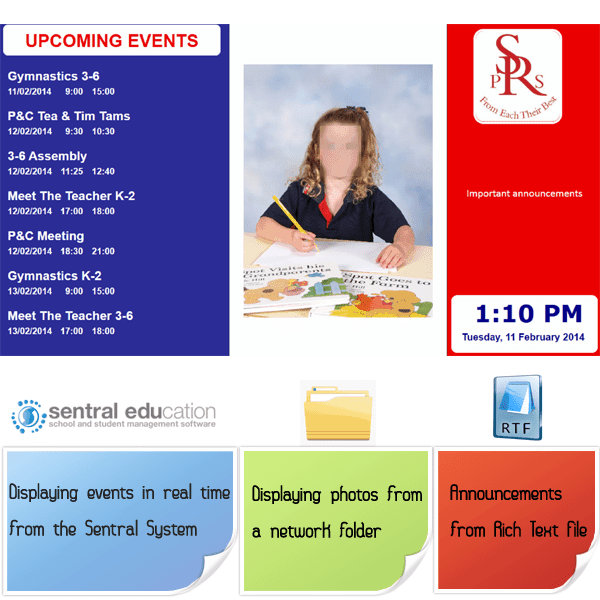
The result
The photo speaks for itself.
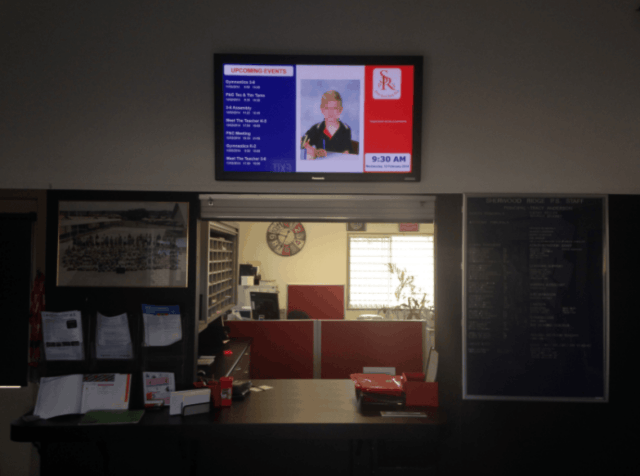
The Benefits
The benefits:
- Update information quickly and easily
- Update event information from one central system
- Minimise repetitive tasks
- Remove the need to open multiple programs
- Remotely update information from any computer
The Nitty Gritty
We decided to provide you with some screenshots of the digital signage software we used for this solution (using PADS4) and how we setup each component.
1. Sentral Calendar
Our software uses a Data Provider to connect to databases, csv files, text files, Exchange calendars, Social Media sites (Facebook, Twitter, Google+, Google Calendar, Youtube, Flickr, Picasa and Instagram), Media RSS feed, JSON feed, Open Office, JSON file, Delphi, Microsoft Exchange, XML and RSS Feeds. This allows our system to quickly and easily update information in real time or on a scheduled basis.
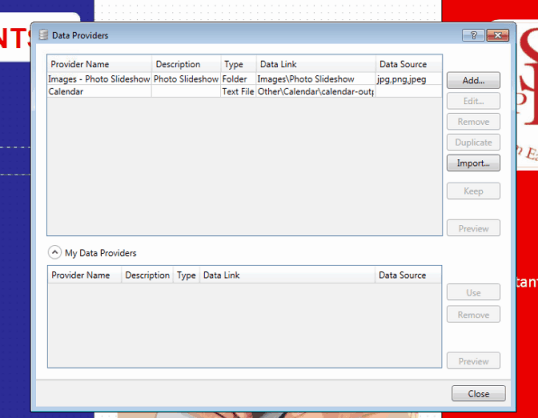
In the software you select which data provider you want to use and which field you want to display.
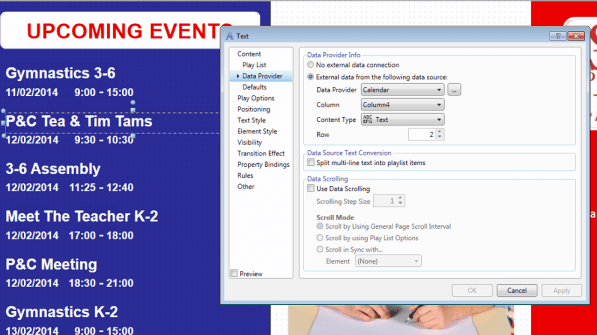
2. Photos
This unique feature of the software allows you to specify which network/local folder the system should display the images from. All the user has to do is drag and drop or cut and paste the image to this folder. Our system then automatically display the images on the screen.
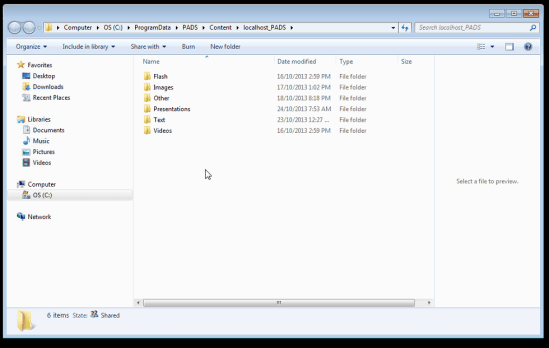
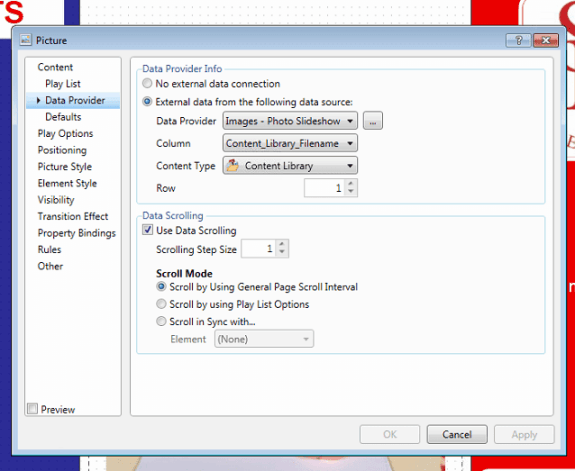
Our system is able to display the file names or folders of each of the images on the screens as well. Here’s a preview of the data source for images.
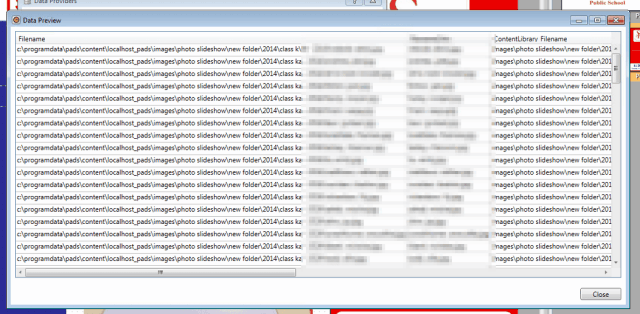
3. Announcements
The announcement section on the screen is driven by a Rich Text File. The benefit of using a Rich Text file versus a plain text file (when you use notepad) is the formatting and the ability to include pictures. Using RTF files allows the system to display text with better formatting and style.
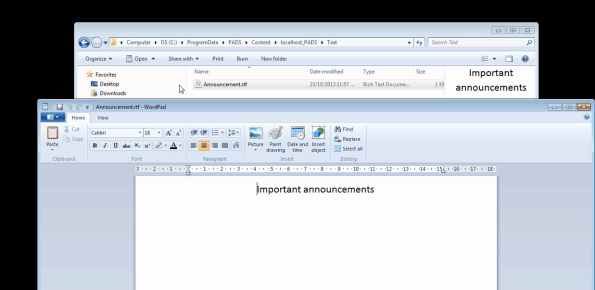
The final template within the software is as follows:
